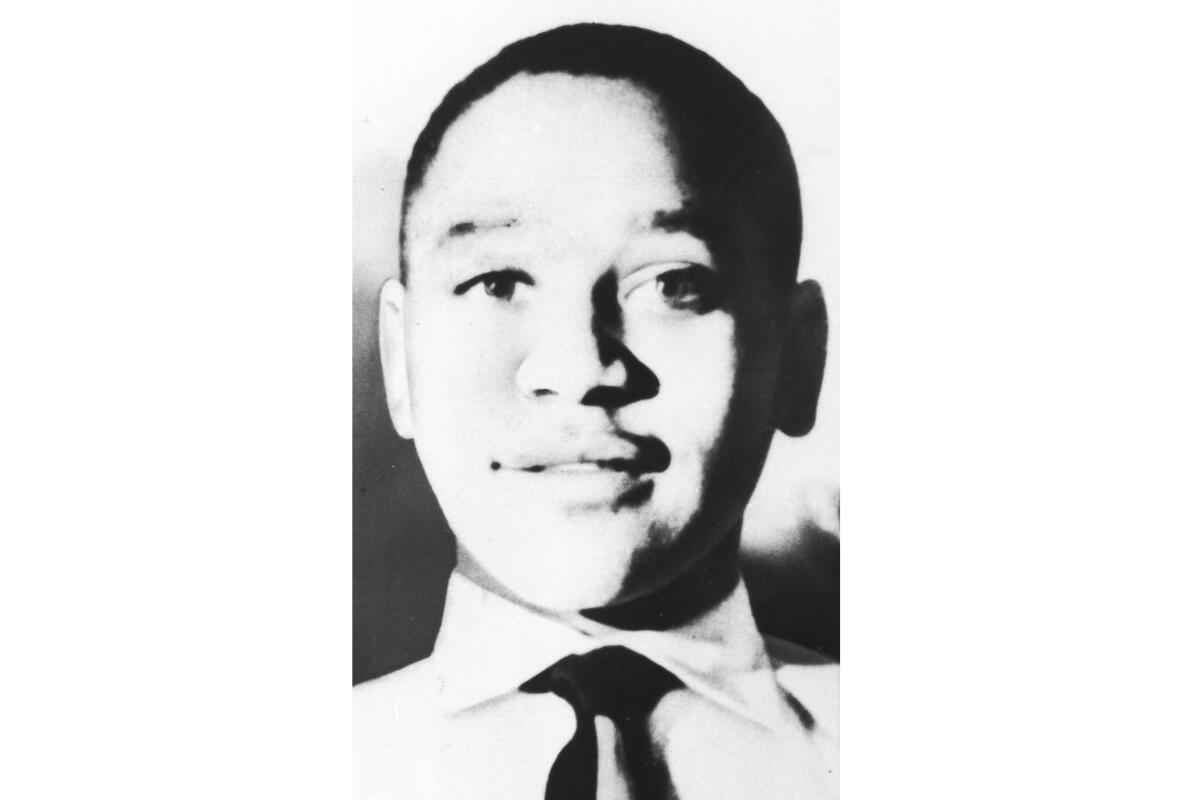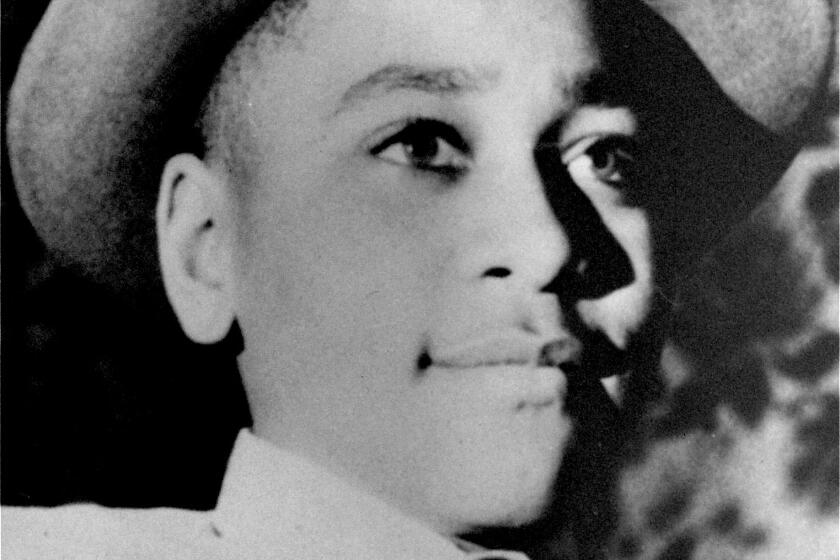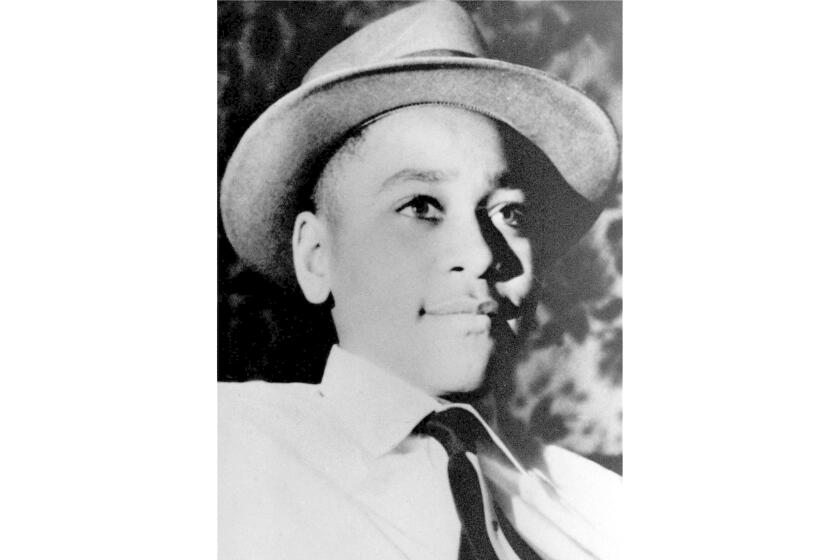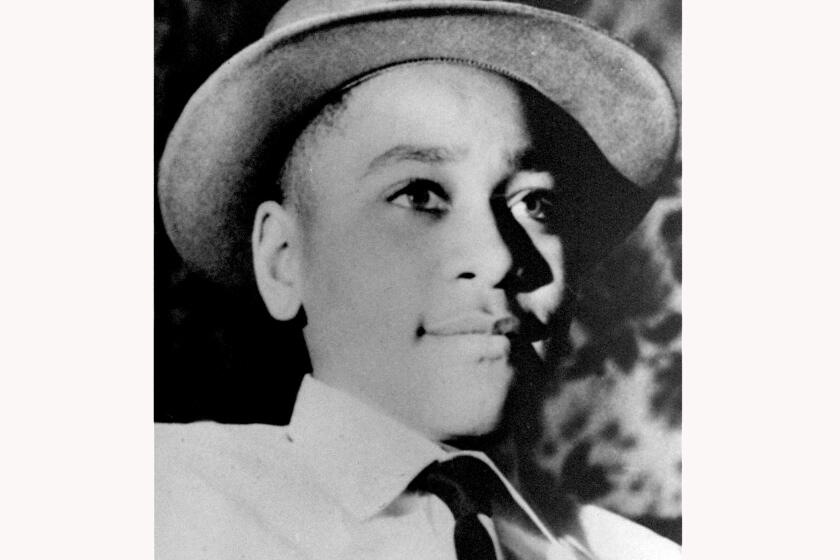For Emmett Till’s family, national monument proclamation cements his inclusion in the American story

- Share via
When President Biden signed a proclamation this week establishing a national monument honoring Emmett Till and his mother, Mamie Till-Mobley, it marked the fulfillment of a promise Till’s relatives made after his death 68 years ago.
The Black teenager from Chicago, whose abduction, torture and killing in Mississippi in 1955 helped propel the civil rights movement, is now an American story, not just a civil rights story, said Till’s cousin the Rev. Wheeler Parker Jr.
“It has been quite a journey for me from the darkness to the light,” Parker said Tuesday during a proclamation signing ceremony at the White House attended by dozens, including other family members, members of Congress and civil rights leaders.
“Back then in the darkness, I could never imagine the moment like this, standing in the light of wisdom, grace and deliverance,” he said.
With the stroke of Biden’s pen, the Emmett Till and Mamie Till-Mobley National Monument, located across three sites in two states, became federally protected places. Before signing the proclamation, the president said he marvels at the courage of the Till family to “find faith and purpose in pain.”
“Today, on what would have been Emmett’s 82nd birthday, we add another chapter in the story of remembrance and healing,” Biden said.
It’s the fourth such designation by the Democratic president’s administration, reflecting its broader civil rights agenda, the White House said. The move comes as conservative leaders, mostly at the state and local levels, push legislation that limits the teaching of slavery and Black history in public schools.
“At a time when there are those who seek to ban books [and] bury history, we’re making clear, crystal clear,” Biden said, “we can’t just choose to learn what we want to know. We should know everything — the good, the bad, the truth of who we are as a nation. That’s what great nations do.”
On Tuesday, reaction poured in from other elected officials and from the civil rights organizing community. The Rev. Al Sharpton said the Till national monument designation tells him “that out of pain comes power.”
House Democratic Leader Hakeem Jefferies of New York said the monument “places the life and legacy of Emmett Till among our nation’s most treasured memorials.”
“Black history is American history,” he said in a written statement.
Till’s family members, along with a national organization seeking to preserve Black cultural heritage sites, say their work protecting the Till legacy continues. They hope to raise money to restore the sites and develop educational programming to support their inclusion in the National Park System.
A team searching a Mississippi courthouse found the warrant charging a white woman in Emmett Till’s kidnapping.
Brent Leggs, executive director of the African American Cultural Heritage Action Fund, a program of the National Trust for Historic Preservation, said the federal designation is a milestone in a yearslong effort to preserve and protect places tied to events that have shaped the nation and that symbolize national wounds.
“We believe that not until Black history matters will Black lives and Black bodies matter,” he said. “Through reckoning with America’s racist past, we have the opportunity to heal.”
The African American Cultural Heritage Action Fund has provided $750,000 in grant funding since 2017 to help rescue sites important to the Till legacy. With its partners, the Andrew Mellon Foundation and the Lilly Endowment, Leggs said an additional $5 million in funding has been secured for specialized preservation of the sites.
Biden’s proclamation protects places that are central to the story of Emmett Till’s life and death at age 14, the acquittal of his white killers by an all-white jury and his late mother’s activism.
In the summer of 1955, Mamie Till-Mobley put her son Emmett on a train to her native Mississippi, where he was to spend time with his uncle and his cousins. In the overnight hours of Aug. 28, 1955, Emmett was taken from his uncle’s home at gunpoint by two vengeful white men.
Emmett’s alleged crime? Flirting with the wife of one of his kidnappers.
Three days later, a fisherman on the Tallahatchie River discovered the teenager’s bloated corpse — one of his eyes was detached, an ear was missing, his head was shot and bashed in.
Till-Mobley demanded that Emmett’s mutilated remains be taken back to Chicago for a public, open casket funeral that was attended by tens of thousands of people. Graphic images taken of Emmett’s remains, sanctioned by his mother, were published by Jet magazine and propelled the civil rights movement.
The Senate passes a bill to award the Congressional Gold Medal posthumously to Emmett Till, the Chicago teenager killed by white supremacists in the 1950s, and his mother, Mamie Till-Mobley.
At the trial of his killers in Mississippi, Till-Mobley bravely took the witness stand to counter the perverse image of her son that defense attorneys had painted for jurors and trial watchers.
Altogether, the Till national monument includes 5.7 acres of land and two historic buildings. The Mississippi sites are Graball Landing, the spot where Emmett’s body was pulled from the Tallahatchie River just outside of Glendora, Miss., and the Tallahatchie County Second District Courthouse in Sumner, where Emmett’s killers were tried.
The U.S. Justice Department has told relatives of Emmett Till it is ending its investigation into the Black teenager’s lynching in 1955.
There is already the Emmett Till Interpretive Center in Sumner, which received philanthropic funding to expand programming and pay staff who interface with visitors.
At Graball Landing, a memorial sign installed in 2008 had been repeatedly stolen and was riddled with bullets. An inch-thick bulletproof sign was erected at the site in October 2019.
A new bulletproof memorial to Emmett Till was dedicated Saturday in Mississippi after previous historical markers were repeatedly vandalized.
The Illinois site is Roberts Temple Church of God in Christ in Chicago, where Emmett’s funeral was held in September 1955.
Mississippi state Sen. David Jordan, 90, was a freshman at Mississippi Valley College in 1955 when he attended part of the trial of the two men charged with killing Till. As a state senator for the last 30 years, Jordan, who is Black, led an effort to get money for a statue of Till that was dedicated last year in Greenwood, Miss., a few miles from where the teenager was abducted.
On Tuesday, Jordan praised Biden for creating the Till national monument.
“It’s one of the greatest honors that a president could pay to a person, 14, who lost his life in Mississippi that’s created a movement that changed America,” Jordan told the AP.
The Till national monument joins dozens of federally recognized landmarks, buildings and other places in the Deep South, in the North and out West that represent historical events and tragedies from the civil right movement. For example, in Atlanta, sites representing the life and legacy of the Rev. Martin Luther King Jr., including his birth home and Ebenezer Baptist Church, are all part of the National Park Service.
The investigation into the lynching of Black teenager Emmett Till in Mississippi nearly 70 years ago ended as it began, with a mystery that might never be solved.
The designation often requires public and private entities to work together on developing interpretation centers at each of the sites, so that anyone who visits can understand the site’s significance. The hiring of park rangers is supported through partnerships with the National Park Foundation, the park service’s official nonprofit, and the National Parks Conservation Assn.
Increasingly, the park service includes sites “that are part of the arc of justice in this country, both telling where we’ve come from, how far we’ve come, and frankly, how far we have to still go,” said Will Shafroth, the president and chief executive of the National Park Foundation. His organization made a $3-million investment in preservation of the Mississippi sites, along with the Fund II Foundation and the Mellon Foundation.
For Parker, who was 16 years old when he witnessed Emmett’s abduction, the Till monument proclamation begins to lift the weight of trauma that he has carried for most of his life.
“I’ve been suffering for all these years of how they’ve portrayed him — I still deal with that,” Parker, 84, said of his cousin Emmett.
“The truth should carry itself, but it doesn’t have wings. You have to put some wings on it.”
More to Read
Sign up for Essential California
The most important California stories and recommendations in your inbox every morning.
You may occasionally receive promotional content from the Los Angeles Times.













